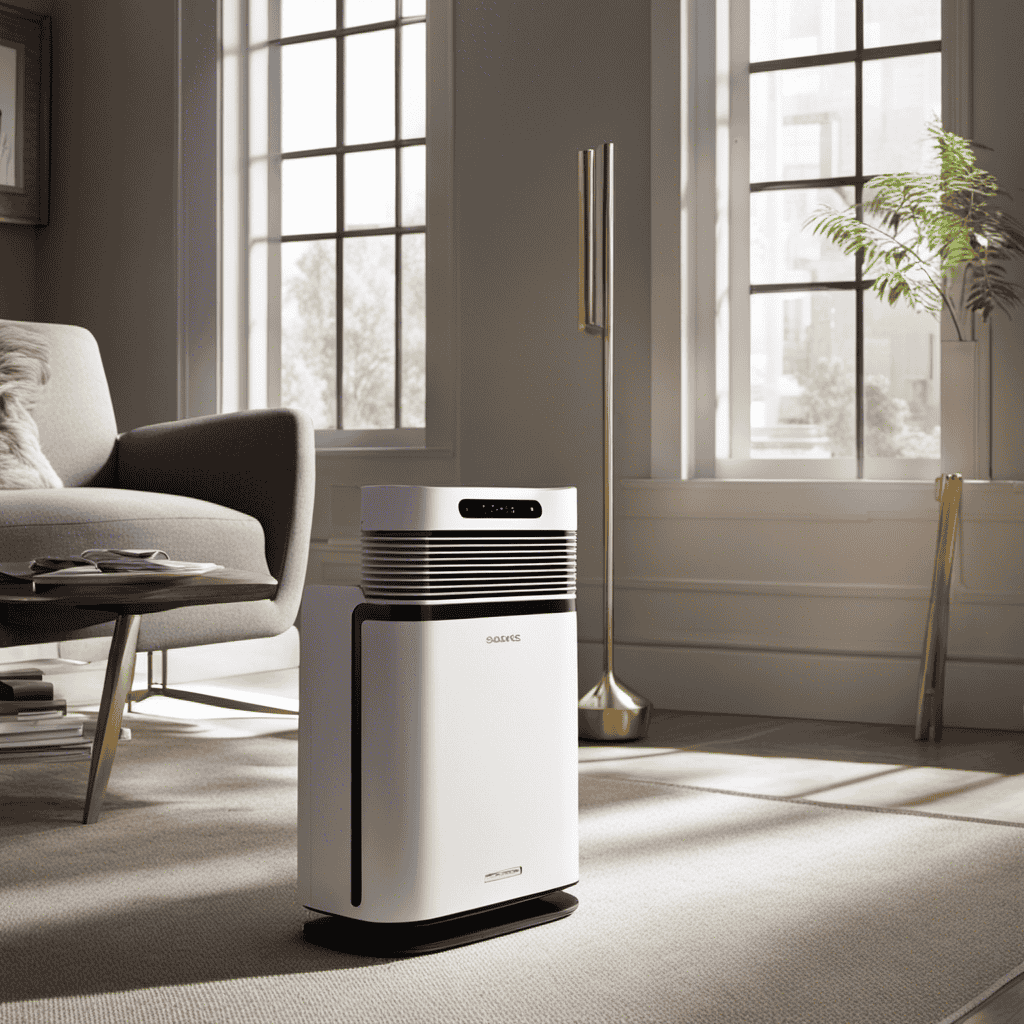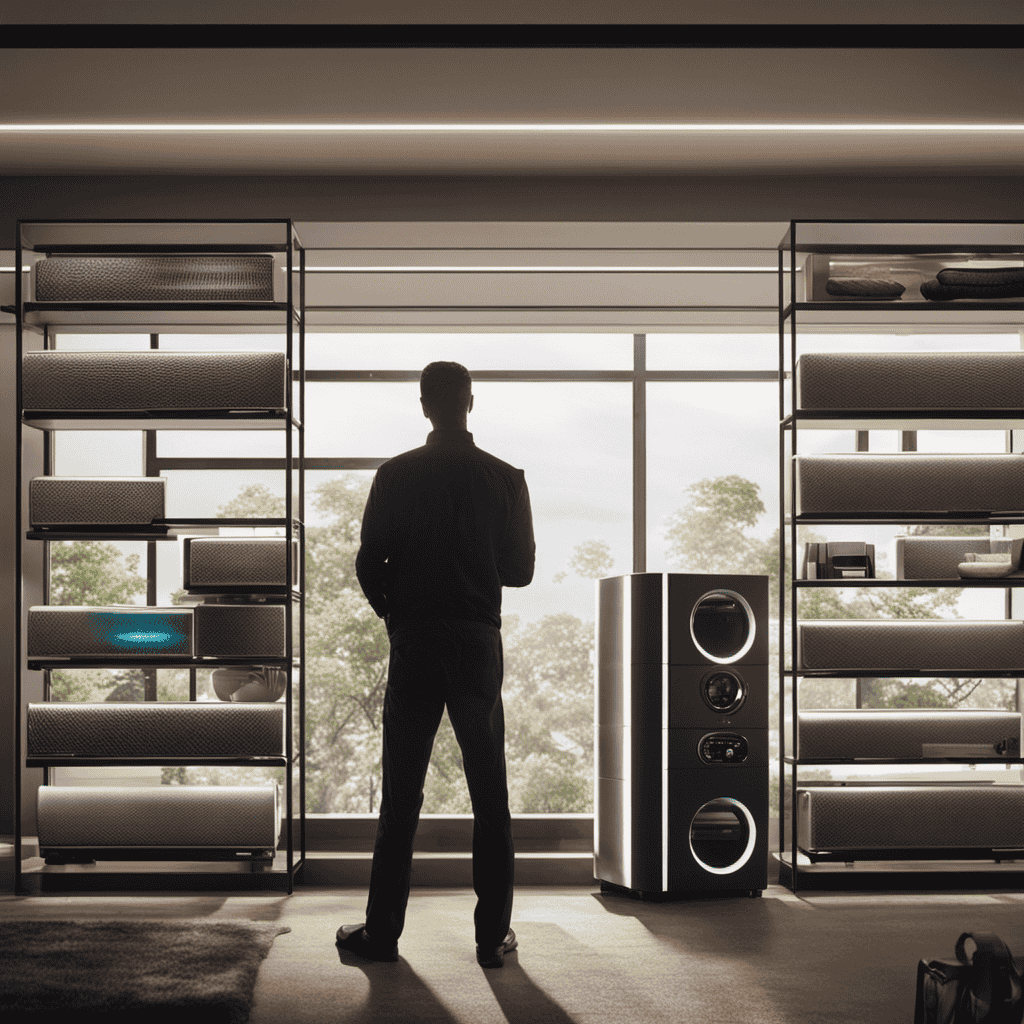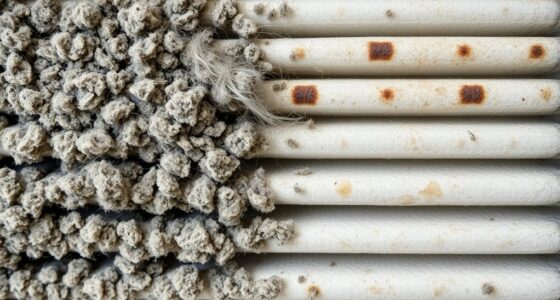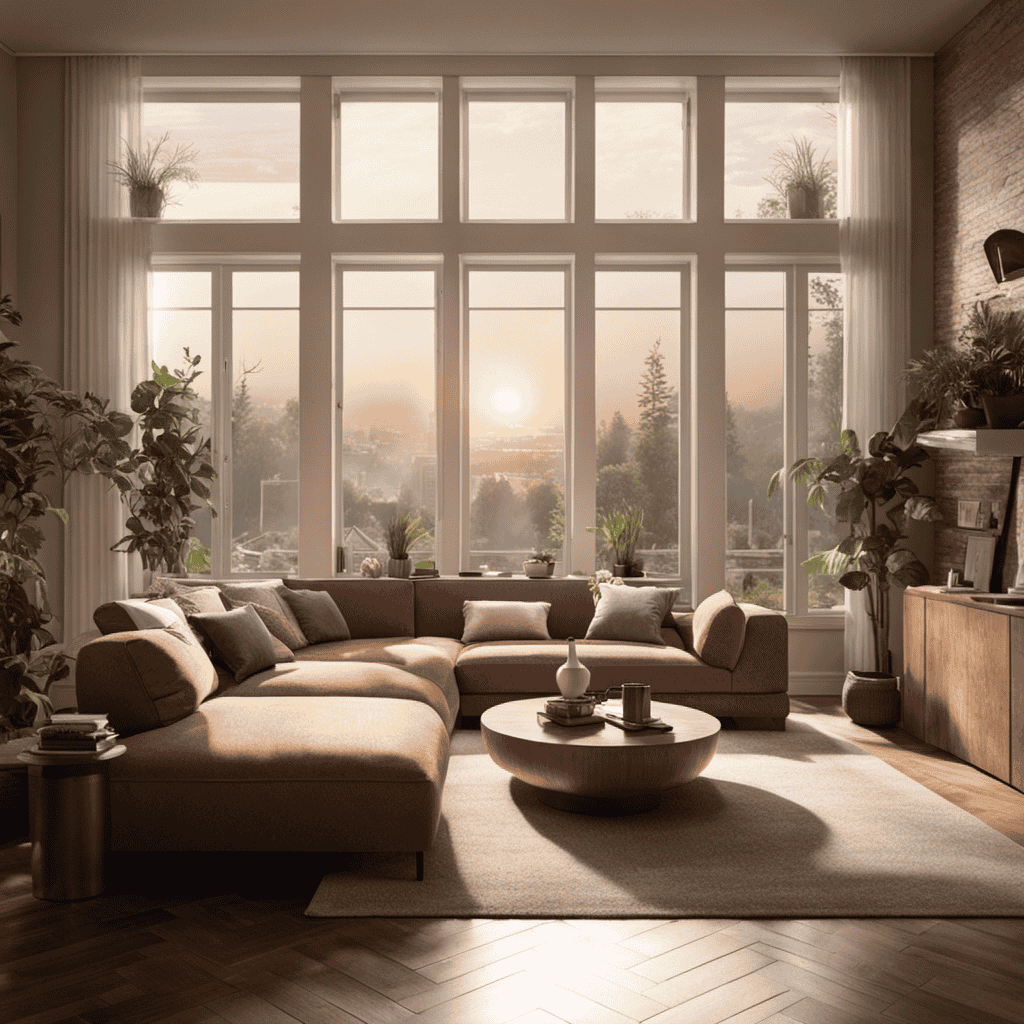When looking for the top room air purifier, it can feel like finding a needle in a haystack. With a plethora of options available, it can be daunting to figure out which one will effectively get the job done.
That’s why I’ve done the research for you. In this article, I’ll guide you through the factors to consider, the different types available, and the top-rated purifiers on the market.
Get ready to breathe in clean, fresh air like never before.
Key Takeaways
- Consider the size of the room and specific air quality concerns when choosing a room air purifier.
- Choose between filter-based purifiers and ionizers based on your needs and concerns.
- Look for air purifiers with low noise levels, especially those with quiet modes or noise levels below 50 dB.
- Opt for energy-efficient options that have features such as smart sensors, automatic shut-off timers, and low power settings to minimize energy usage and save on costs.
Factors to Consider When Choosing a Room Air Purifier
When choosing a room air purifier, it’s important to consider factors such as the size of the room and the specific air quality concerns.
Proper air purifier maintenance is essential for ensuring its effectiveness and longevity. Regularly cleaning and replacing filters is crucial to keep the air purifier working optimally.
Additionally, it’s important to consider the benefits of air purifiers when making a decision. Air purifiers can greatly improve indoor air quality by removing pollutants such as dust, pollen, pet dander, and mold spores. This can lead to a cleaner and healthier living environment, especially for those with allergies or respiratory conditions.
Different Types of Room Air Purifiers
When choosing a room air purifier, it is important to consider the different types available. One key point to consider is the choice between a filter-based air purifier or an ionizer.
Filter-based purifiers are known for their ability to remove various particles from the air, while ionizers use electrically charged ions to remove pollutants.
Another important aspect to compare is the noise level of the purifiers. Some models may produce more noise than others, so it is crucial to choose one that suits your preferences and environment.
Additionally, energy efficiency is a significant factor to consider. Look for purifiers that have energy-saving options or certifications, as they can help you save on electricity costs in the long run.
Filter Vs. Ionizer
If you want to improve indoor air quality, you should consider whether a filter or an ionizer is the better option for you. Both options have their advantages and disadvantages, so it’s important to understand their effectiveness and the technologies behind them.
Air purifiers with filters, such as HEPA filters, are highly effective in removing particles like dust, pollen, and pet dander from the air. These filters work by capturing particles as air passes through them.
On the other hand, ionizers use charged particles to attract and remove contaminants from the air. They release negative ions that attach to airborne particles, causing them to fall to the ground or stick to surfaces.
While both options can improve indoor air quality, filters are generally more effective at removing particles, while ionizers are better at neutralizing odors and smoke.
It’s important to choose the option that best suits your specific needs and concerns.
Noise Level Comparison
To determine which option is right for you, consider the noise levels of filters and ionizers. When it comes to air purifiers, quiet operation is a key factor to consider. Nobody wants a noisy machine disrupting their peace and quiet. The noise level of an air purifier is measured in decibels (dB), and it is important to find one that operates at a low decibel level.
Look for air purifiers that have a quiet mode or a noise level below 50 dB. This will ensure that the purifier does not disturb your sleep or daily activities. Some brands even offer ultra-quiet models that operate at a barely audible level.
Now that we have addressed the noise factor, let’s move on to the next section about energy efficiency options.
Energy Efficiency Options
One important aspect to consider is the energy efficiency of different models. When choosing a room air purifier, it is essential to look for energy-saving features that can help reduce electricity consumption and save on energy costs.
Many modern air purifiers come with advanced technologies such as smart sensors, automatic shut-off timers, and energy-efficient motors. These features not only minimize energy usage but also ensure optimal performance and longer lifespan of the device.
Additionally, certain air purifiers are designed to operate on low power settings, making them more cost-effective options in the long run.
Top-Rated Room Air Purifiers on the Market
When it comes to choosing a room air purifier, there are several key points to consider: performance and effectiveness, features and specifications, and user reviews and ratings.
Performance and effectiveness are crucial factors to evaluate as they determine how well the air purifier can remove pollutants and improve air quality.
Features and specifications, such as the type of filtration system, coverage area, and noise level, can help determine if the air purifier meets your specific needs and preferences.
Lastly, user reviews and ratings provide valuable insights from people who have already used the product, allowing you to make an informed decision based on others’ experiences.
Performance and Effectiveness
You should consider the performance and effectiveness of different room air purifiers before making a purchase. When evaluating air purifiers, it’s important to look at their ability to remove pollutants from the air and improve overall air quality. To help you make an informed decision, here is a comparison table highlighting the performance and effectiveness of three popular air purifiers:
| Air Purifier | CADR Rating (Smoke) | HEPA Filter Efficiency | Noise Level |
|---|---|---|---|
| Purifier A | 300 | 99.97% | 40 dB |
| Purifier B | 250 | 99.99% | 35 dB |
| Purifier C | 350 | 99.95% | 45 dB |
From this table, we can see that Purifier C has the highest CADR rating, indicating its ability to remove smoke particles quickly. Purifier B has the highest HEPA filter efficiency, ensuring the capture of even the smallest airborne particles. Lastly, Purifier B has the lowest noise level, making it a quieter option for your home. Considering these factors will help you select an air purifier that meets your specific needs. Now let’s move on to the features and specifications of these air purifiers.
Features and Specifications
To compare the features and specifications of different air purifiers, take a look at the table below:
- HEPA filtration system: Removes 99.97% of airborne particles, including dust, pollen, and pet dander.
- Activated carbon filter: Eliminates odors and volatile organic compounds (VOCs).
- Smart sensors: Automatically detect and adjust the fan speed based on air quality.
- Timer function: Allows you to set specific operating hours for energy efficiency.
Air purifier technology advancements have greatly improved the performance and convenience of these devices. With regular air purifier maintenance, such as cleaning or replacing filters, you can ensure optimal functioning.
Manufacturers have also introduced features like filter replacement indicators, Wi-Fi connectivity for remote control, and air quality monitoring through smartphone apps. These advancements make it easier for users to maintain clean air in their homes.
Now, let’s delve into user reviews and ratings to gain insights on actual experiences with different air purifier models.
User Reviews and Ratings
Check out what other users are saying about different air purifier models and their experiences with them. User experiences and product recommendations can provide valuable insights when choosing the best room air purifier.
Many users have praised the effectiveness of air purifiers in improving indoor air quality and reducing allergens. Some users have shared their experiences with specific models, highlighting features such as HEPA filters, activated carbon filters, and quiet operation.
These user reviews can help potential buyers make informed decisions based on real-world experiences. Additionally, product recommendations from trusted sources like consumer review websites or online forums can further assist in finding the best air purifier for individual needs.
It is important to consider a variety of user experiences and recommendations to ensure the chosen air purifier meets specific requirements.
How to Determine the Size of Air Purifier You Need
When it comes to determining the size of air purifier you need, start by calculating the square footage of the room. This will help you choose an air purifier that is powerful enough to effectively clean the air in the space.
Here are some key factors to consider:
- Room size: Measure the length and width of the room and multiply them to get the square footage.
- Air changes per hour: Consider how often you want the air in the room to be completely filtered. A higher air change per hour (ACH) rate is recommended for those with allergies or asthma.
- CADR rating: Look for an air purifier with a Clean Air Delivery Rate (CADR) that matches the size of your room. The higher the CADR, the more effective the purifier will be.
- Filter type: Choose a purifier with the appropriate filter for your needs. HEPA filters are highly effective in removing allergens and pollutants.
To keep your air purifier running efficiently, remember to regularly clean or replace the filters and follow the manufacturer’s maintenance tips.
Understanding Air Purifier Filters and Their Efficiency
Understanding the different types of filters and how efficient they are is essential when choosing an air purifier. Air purifier technology advancements have led to various filter options that can effectively remove pollutants from the air in our homes.
The most common types of filters include HEPA filters, activated carbon filters, and ionizers. HEPA filters are known for their high efficiency in capturing small particles, such as pollen, dust mites, and pet dander. Activated carbon filters are effective in removing odors and harmful chemicals. Ionizers use charged particles to attract and remove pollutants from the air.
When it comes to air purifier maintenance, it is important to regularly clean or replace the filters to ensure optimal performance. By understanding the different filter options and their efficiency, we can choose an air purifier that best suits our needs and provides cleaner and healthier air in our homes.
Now, let’s move on to discussing the noise levels of room air purifiers and what to expect.
Noise Levels of Room Air Purifiers: What to Expect
You’ll want to take into consideration the noise levels of different models before choosing an air purifier for your home. The noise produced by an air purifier can have a significant impact on your sleep quality, so it’s important to find a model that operates quietly.
Here are some things to keep in mind when thinking about air purifier noise levels:
-
Whisper-quiet operation: Some air purifiers are designed to operate almost silently, allowing you to sleep peacefully without any disturbances.
-
White noise effect: For those who find it difficult to fall asleep in complete silence, a slightly audible air purifier can create a soothing white noise effect that promotes better sleep.
-
Adjustable fan speeds: Look for models that offer multiple fan speed settings, so you can adjust the noise level to your preference.
-
Noise reduction technology: Certain air purifiers come with advanced noise reduction technology, minimizing any disruptive sounds.
Energy Efficiency: Finding an Air Purifier That Saves on Power Consumption
Finding an air purifier that saves on power consumption is essential for reducing energy costs and minimizing environmental impact. When it comes to saving energy, there are several cost-effective options available in the market.
One of the key factors to consider is the purifier’s energy efficiency rating. Look for models that are ENERGY STAR certified, as they have been tested and proven to meet strict efficiency standards.
Additionally, consider the size of the room you intend to use the purifier in. Choosing the right size will ensure that the purifier operates efficiently without wasting energy.
By selecting an air purifier that saves on power consumption, you not only save on energy costs but also contribute to a greener environment.
Now let’s explore the importance of CADR ratings for air purifiers.
The Importance of CADR Ratings for Air Purifiers
In my search for the best room air purifier, I discovered that energy efficiency is not the only factor to consider. Another important aspect to look into is the CADR ratings, which stand for Clean Air Delivery Rate.
CADR ratings determine the effectiveness of an air purifier in removing specific airborne pollutants from the room. So, while an energy-efficient air purifier may save on power consumption, it might not be as effective in purifying the air.
Here are some key points to consider when looking at CADR ratings:
- CADR ratings measure the amount of clean air that an air purifier can deliver in cubic feet per minute (CFM).
- The higher the CADR ratings for a particular pollutant, the more effective the air purifier is at removing that specific pollutant.
- CADR ratings cover three main pollutants: smoke, pollen, and dust.
- It is recommended to choose an air purifier with CADR ratings that are at least two-thirds of the room’s size for effective air purification.
Features to Look for in a Room Air Purifier
When considering features for a room air purifier, it’s important to prioritize the size of the space it can effectively purify. According to the air purifier buying guide, the coverage area is a crucial factor to consider. A purifier that is too small for your room will not effectively clean the air, while one that is too large may consume unnecessary energy.
To determine the appropriate size, measure the square footage of your room and choose a purifier that can handle that size. Additionally, look for features like HEPA filters, activated carbon filters, and UV-C light technology. These features can help remove particles, allergens, and odors from the air.
By selecting a purifier with the right size and features, you can ensure cleaner and healthier air in your space.
Now, let’s move on to how to clean and maintain your room air purifier.
How to Clean and Maintain Your Room Air Purifier
To keep your room air purifier running efficiently, it’s essential to regularly clean and maintain it. Neglecting the maintenance of your air purifier can lead to decreased performance and even potential health hazards.
Here are some cleaning tips to ensure optimal functionality:
-
Cleaning the filters: Regularly clean or replace the filters to remove dust, pollen, and other particles from the air.
-
Wiping down the exterior: Use a damp cloth to remove dust and grime from the exterior of the purifier.
-
Cleaning the fan: Gently clean the fan blades to prevent the buildup of dirt and ensure smooth airflow.
-
Clearing the air vents: Regularly check and clear any obstructions in the air vents to maximize air circulation.
Tips for Optimizing the Performance of Your Air Purifier
Regularly cleaning and maintaining your air purifier will help optimize its performance and ensure cleaner, healthier indoor air. Here are some tips for air purifier maintenance that will help improve the air quality in your home:
| Maintenance Tips | Frequency | Benefits |
|---|---|---|
| Replace filters | Every 3-6 months | Removes dust, pollen, and other particles |
| Clean exterior | Monthly | Removes dust and improves airflow |
| Vacuum pre-filter | Every 2 weeks | Extends the life of the main filter |
| Check fan and motor | Annually | Ensures efficient operation |
| Monitor air quality | Regularly | Adjusts settings based on pollution levels |
Health Benefits of Using a Room Air Purifier
Using a room air purifier can greatly improve the quality of indoor air. Not only does it help remove allergens and pollutants, but it also reduces respiratory issues.
Studies have shown that air purifiers can effectively filter out harmful particles, leading to cleaner air and potentially reducing the risk of respiratory diseases.
Cleaner Indoor Air
Having an air purifier can help improve the quality of indoor air. There are several benefits to using an air purifier, including:
-
Removing allergens: An air purifier can capture and remove common allergens such as pollen, dust mites, and pet dander, reducing the risk of allergic reactions.
-
Eliminating odors: Whether it’s cooking smells, pet odors, or cigarette smoke, an air purifier can help eliminate unpleasant odors, leaving your indoor environment fresh and clean.
-
Reducing airborne bacteria and viruses: Air purifiers with HEPA filters can trap and eliminate airborne bacteria and viruses, reducing the spread of illnesses and improving overall health.
-
Filtering out pollutants: Indoor air can contain pollutants such as volatile organic compounds (VOCs) and chemicals. An air purifier with activated carbon filters can effectively remove these pollutants, creating a healthier living space.
Reduces Respiratory Issues
In addition to cleaner indoor air, another benefit of using a room air purifier is the reduction of respiratory issues. As someone who suffers from allergies and asthma, I understand the importance of breathing in clean air.
Air purifiers work by removing airborne particles such as dust, pollen, and pet dander, which can trigger respiratory symptoms. This can lead to improved sleep quality, as breathing in clean air can help alleviate nighttime coughing and congestion.
Not only does this benefit humans, but it also has advantages for our furry friends. Pets can also suffer from allergies and asthma, and having an air purifier can help alleviate their symptoms as well.
Now that we understand how air purifiers can reduce respiratory issues, let’s explore their effectiveness in allergen and pollutant removal.
Allergen and Pollutant Removal
Now that we’ve covered how air purifiers can reduce respiratory issues, let’s explore how effective they are at removing allergens and pollutants.
Using a HEPA air purifier in your home can offer several benefits in reducing allergens. Here are some tips for reducing allergens in the home and the benefits of using a HEPA air purifier:
-
HEPA filtration: A HEPA air purifier is designed to capture particles as small as 0.3 microns, including pollen, pet dander, and dust mites.
-
Improved indoor air quality: By removing allergens, a HEPA air purifier can help improve the overall air quality in your home, reducing allergy symptoms.
-
Odor elimination: HEPA air purifiers also have activated carbon filters that can effectively remove odors, such as those caused by pets, cooking, or smoke.
-
Peace of mind: Using a HEPA air purifier can provide peace of mind knowing that you are creating a healthier environment for yourself and your family.
These tips and benefits highlight why using a HEPA air purifier can be an effective solution for reducing allergens and pollutants in your home.
Common Air Pollutants and How an Air Purifier Can Remove Them
Air purifiers can effectively remove common air pollutants, such as dust, pollen, and pet dander. With advancements in air purifier technology, their ability to capture and eliminate these pollutants has greatly improved.
Research has shown that exposure to air pollution can have detrimental effects on our health. Dust and pollen can trigger allergies and respiratory issues, while pet dander can worsen asthma symptoms. By using an air purifier, we can reduce our exposure to these harmful substances and improve indoor air quality.
These devices work by using filters and other technologies to trap and remove pollutants from the air. HEPA filters, for example, can capture particles as small as 0.3 microns, effectively removing dust, pollen, and pet dander.
Investing in an air purifier can help protect our health by reducing our exposure to common air pollutants.
Can Air Purifiers Help With Allergies and Asthma
To alleviate your allergies and asthma symptoms, using an air purifier can be beneficial. Here are some ways air purifiers can help improve your quality of life:
-
Breathing in cleaner air: Air purifiers remove allergens and irritants from the air, such as pollen, dust mites, and mold spores. This can reduce the frequency and severity of allergy and asthma attacks.
-
Reducing pet dander: If you have pets, their dander can trigger allergies and asthma symptoms. Air purifiers with HEPA filters can capture pet dander and other pet-related allergens, improving indoor air quality.
-
Improving sleep quality: Air purifiers can create a healthier sleep environment by removing airborne particles that can irritate your respiratory system. This can lead to better sleep and less disturbance from symptoms during the night.
-
Eliminating odors: Air purifiers with activated carbon filters can help eliminate unpleasant odors, such as pet odors or cooking smells, improving the overall freshness of your living space.
Incorporating an air purifier into your home can provide relief from allergies and asthma symptoms, allowing you to breathe easier and enjoy a better quality of life.
Comparison of Room Air Purifiers: Pros and Cons
Comparing different room air purifiers can help you determine which one is best suited for your needs. When it comes to air purifier brands, there are several options available in the market. Some popular brands include Dyson, Honeywell, and GermGuardian. Each brand has its own unique features and benefits.
In terms of cost comparison, Dyson air purifiers are known for their high price tags. They are known for their advanced technology and sleek design, but they may not be suitable for everyone’s budget. On the other hand, Honeywell and GermGuardian offer more affordable options without compromising on quality.
It is important to consider your specific needs and budget when comparing air purifiers. Look for features like HEPA filters, room coverage, noise levels, and energy efficiency. Reading reviews and comparing specifications can help you make an informed decision and find the best air purifier for your home.
Can the Best Room Air Purifier Also be Used as a Whole House Air Purifier?
Yes, the best whole house air purifier can also be used as a room air purifier. These purifiers are designed to cover large spaces, so using them in a single room would be highly effective. Just be sure to check the coverage area of the purifier to ensure it meets your needs.
Frequently Asked Questions
Are Air Purifiers Effective in Removing Specific Allergens, Such as Pet Dander or Pollen?
Yes, air purifiers are effective in reducing specific allergens like pet dander or pollen. Different technologies, such as HEPA filters or activated carbon, can remove these pollutants from indoor air, improving overall air quality.
Can Air Purifiers Help With the Elimination of Odors, Such as Cigarette Smoke or Cooking Smells?
Yes, air purifiers can effectively eliminate strong odors like cigarette smoke and cooking smells. They can also improve indoor air quality for individuals with respiratory conditions by removing pollutants and allergens from the air.
How Often Should the Filters in an Air Purifier Be Replaced?
When to replace air purifier filters is an important consideration. Regular cleaning is crucial for optimal performance. Depending on usage and manufacturer’s recommendation, filters should generally be replaced every 6-12 months.
Can Air Purifiers Be Used in Larger Spaces, Such as Open-Concept Living Areas or Offices?
Air purifiers can be used in larger spaces like open-concept living areas or offices. They can improve air quality by removing pollutants, allergens, and odors, creating a healthier and more comfortable environment.
Are There Any Potential Health Risks Associated With Using an Air Purifier for Extended Periods of Time?
Extended use of air purifiers may have potential side effects, but the evidence on long term health effects is limited. It is important to consider factors like air quality, maintenance, and individual sensitivities when using an air purifier for extended periods.
Conclusion
After analyzing the factors and researching the different types of room air purifiers, it is clear that the best room air purifier for you depends on your specific needs.
The top-rated purifiers on the market offer various features and technologies to effectively remove common air pollutants. Understanding the size of the purifier you need and the efficiency of its filters is crucial for optimal performance.
With its ability to remove allergens and improve air quality, an air purifier can provide significant health benefits. So, don’t hesitate to invest in the right purifier for a breath of fresh air.










